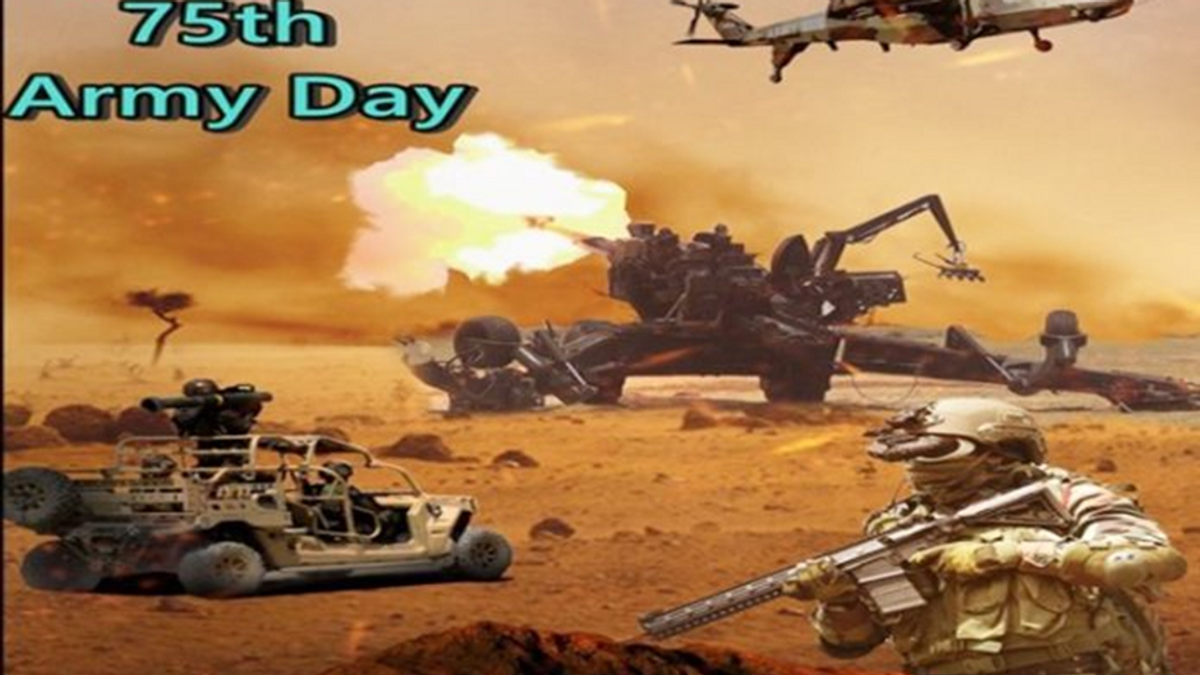
Modernised Indian Army: Now a Happier Lot
On 15 Jan 2023, Indian Army celebrated its 75th Army raising Day. The number itself makes it a proud occasion. After India got its independence in 1947, this was the day when Fd Mshl K M Cariappa (then a Lieutenant General) took over as the first Commander-in-chief of the Indian Army from the last British Commander-in-chief of India in the year 1949. Thereafter, this day is always celebrated as Army Day Anniversary with pride. In these 75 yrs, Indian Army has had all proud moments if we leave the 1962 reversals. This occasion is highly ceremonial when there is a parade, giving awards to deserving soldiers, an address by the Chief….all having a single motto of “Service before self”.
Indian Army has always been a highly professional force even under the crunch of resources and upgraded fighting machines in past. Its modernization received a serious setback in last over 3 decades. Till the beginning of the last decade, our Army had serious lack of high Tech weapons. For whatever reasons, the indigenous R&D was extremely slack and import of the state-of-the-art weapons were simply out of question in the absence of funds. We had no efficient battle Tanks, no Howitzers/Artillery system purchased after the infamous Bofors. The hardship was so much that our fighting forces didn’t have even advanced assault rifles. They still had the toy-like INSAS & SLR along with outdated LMGs and MMGs. It was difficult to say who was to be blamed. Army Commanders didn’t put their foot down for the new acquisitions and the political leadership looked the other way to their needs. It was a mockery of defence strategy when our Raksha Mantri Anthony made a statement in the parliament “We don’t want to develop infrastructure in the border areas along LAC through which the enemy could find access”. With such a mindset prevailing in 2012-13, India thanks its stars that there was no repeat of Chinese hostility as it would have put our brave soldiers to peril and made it almost impossible to defend the northern border.
Chinese had already taken possession of the Aksai Chin by 1959-62 and further marched in to Depsang Plains and Daulat Beg Oldie airstrip in 2013 and when pleaded by Indian Govt, they retreated partially to settle into near 450 Sq Km of the Depsang Plains which they continue occupying till now. Our planners were by and large satisfied comparing Indian defence capabilities vis-a-vis Pakistan and reluctantly started a few developmental projects along LAC with intent of not annoying the Chinese PLA. Thanks to the change of govt in 2014 that changed the mindset to start the rapid infrastructure development all along the LAC. Thereafter, Indian Army stood up to the Chinese challenges whether it was Doklam, Eastern Ladakh, Sikkim or Arunachal. Even our enemy on the western border was told in no uncertain terms that there will be price to pay for their nefarious Jihadi acts in India; and they did pay following surgical strikes in PoK and Balakot. However, the changes in the mindset were firmly backed by modernization plans esp the heavier weapons of Artilleries and Tanks. Both Army and the govt realized their limitations when they realized that they didn’t have assault rifles to take on the PLA.
In a short span of 8 yrs, Army has made sharp gains in its capabilities through advanced weapons and Modi Govt has firmly backed them up. There are comprehensive reforms in the Armed Forces…be it trimming the non-combat element, adopting pro-active defense posture, restructuring the Ordinance Factories to meet the requirements of modern munitions for most if not all weapons, gearing up inter-services coordination through CDS or moving to the Theatre-Command concept. All these will provide both Tactical and Strategic depth to our forces esp the Army.
The modernisation plan has taken-off from the year 2015-16 with a jump of nearly 96K Cr annual budget and stood at 471.4K Cr last year (Year 2020-21). This is more than double of what stood at 2014-15, yet the overall allocation is just over 2% of the GDP what used to be nearly 2.5% during UPA’s time. It is because of the huge growth of the GDP in the last few years. Thanks to Galwan incidence that urgent OTS purchases were made and then put in place the indigenisation, make-in-India and ‘self-reliant India’ plans for the manufacture and production of the state-of-the-art defense equipment as well as personal protective measures (such as bullet-proof vest, NVG etc). Modi govt has also drastically improved the living conditions of the soldiers, especially in remote and inhospitable areas. The following are some such procurements: -
All defence experts have opined unanimously that if India has to become a major regional/ global power, it must have its own defence hardware. The emphasis is on Made-in-India as well as make in India. Our Armed Forces will ever remain grateful to the Modi Govt for providing most if not all combat requirements. This included upgradations in the indigenous Arjun Tank for, light Howitzers along with some other equipment mentioned above, so urgently required but the procurements of which were held-up during the UPA govt. The biggest strategic push given to the Army is through the creation of a long-awaited self-contained Mountain Strike Force with rapid deployment capabilities.
Towards the indigenous equipment, Modi Govt did no magic but assisted the developing agencies to overcome the hurdles and bottlenecks in way of meeting the performance requirements. The govt only facilitated global domain experts to interact to resolve the issues. Today, Arjun Tank Mk-1A has excellent features with 71 major and user-driven upgrades. Features like increased mobility, Fire-power accuracy and its enhanced survivability make it world-class and will immensely benefit the Indian Army. In addition, the indigenous equipment will have in-house upgradations, modifications to continuously upgrade the performance and that marginally higher cost is paid to the companies within India which is for the benefits of Indians.
India has also made progress in the military Air Defense Systems that include Radars, Communication Systems and Air & Ground Defense projectiles and missiles. While INDRA Radar developed by DRDO was already in service before 2014, it was only a representative of indigenous systems. The major push has taken place with OEM supported enhanced serviceability guarantees in recent years. Today, INDRA I & II, Rajendra and Rohini Radars are increasingly being installed by both IAF and Army (as well as by Civil Airports), some with even possessing ECM capabilities. Swathi weapon locating radar is another new acquisition for the Army. Indian Ordnance Factories have been reorganised to meet all munition requirements of the Armed Forces that were largely imported till now.
India is self-reliant in its Missile Systems both with conventional and nuclear warheads. It has a series of missiles…Prithvi, Agni, Brahmos, Nirbhay and some more. The range of the missiles are from 290 Km to approx. 8,000 Km. The range is further augmented by its capabilities to be launched from all platforms be it Ground, Aircraft and Underwater Ship/Submarines. These missiles have capabilities for Air-to-Air, Air-to-Ground, Air-to-Waters (& Underwater); Surface to Air, Surface to Surface, Surface to Waters (& Underwater); Water surface to – Air – waters - surface. India also has Low Level Radar avoiding Missiles to knock out high value enemy assets.
Any world class military power that claims to be self-reliant and advanced, have histories of at least five ‘5-year plans’ of intense efforts in achieving its goal. India has started its march in self-reliance in 2015. How long it takes for its own ‘Atmnirbhar’ goals, remains to be seen. However, if no corrupt union govts or those having military sabotaging objectives come at the centre, India should become a global power in the next 20 yrs or so.
Having suffered lack of credible modernisation of military hardware for more than 3 decades, Indian Armed Forces has now received a substantial face-lift with well-planed procurement policies heading towards self-reliance. The present Govt has put the Indian Defence manufacturers on a path to making India Armed Forces a global power. Indian Army is readying itself to meet the current challenges on all frontiers. On the 75th Army Day, every serving and veteran military personnel will be proud of the new force. More or less this is the form of Army that they all wished to be part of....projecting as a mighty regional/global power.
